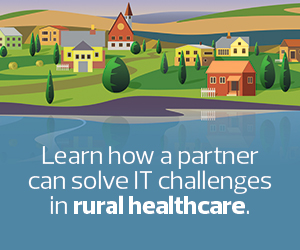Data Can Drive Change for Rural Healthcare
Lindner shared a story of an organization that wanted to know why it was so hard for patients to find appointments for addiction medication. He said it was important to analyze the data because the reason could have been that there were enough providers, but they were hard to find on a website; that there weren’t enough providers and the industry needs to recruit more; or that there were enough providers accepting patients, but they were scheduling them out so far, they might as well have been unavailable.
“You don’t want to jump to a conclusion and try to solve something without understanding what your actual problem is,” said Lindner.
Amy Gleason, chief product officer at Main Street Health, said that many rural healthcare organizations are using older electronic health record systems, and some are still using paper charts. Not having a robust EHR setup makes it difficult for these health systems or clinics to determine which patients have missed screenings or other trends in their patient population. Gleason pointed out that while health plans try to provide their own data to rural organizations, they may all do that in a different way with a different portal. Clinicians don’t have the time to log in to different portals or find out how to get into a spreadsheet — and often, their EHR can’t handle that influx of data anyway.
Reyann Davis, director of value-based care at Texas A&M Rural and Community Health Institute, agreed that data is a challenge in rural healthcare. A critical factor is staffing. Many rural healthcare organizations don’t have a team to implement data infrastructures, meaning that these organizations aren’t able to make the most of the data they collect. They lack the resources to create EHR integrations to enable better data access for clinicians.
Helping rural healthcare organizations improve their data maturity is critical to addressing population health trends and insecurities revealed in social determinants of health data.
“We have to start thinking about innovations that help patients where they are in their community, not just at the clinic but also at home. We need to give them the resources they need to be healthy,” said Davis.
EXPLORE: The Rural Emergency Hospital designation provides opportunities for hospitals.
Overcoming Payer Challenges with Partnerships
One of the major challenges for rural healthcare organizations is the payer shift. According to Davis, cost-based reimbursement had helped rural health systems thrive and survive. Now, with plans such as Medicare Advantage that don’t reimburse enough to cover full costs, many of these organizations are operating in the red.
“If we do not create a way to look at alternative payment models and set up a different payment system in partnership with our rural providers, access may not survive,” she said. “We have to find a way to work together between providers, payers and innovation to test the payment model that makes sense for rural healthcare so they can continue to provide great service.”
Partnerships with vendors, government agencies, nonprofit organizations and other health systems can help rural healthcare organizations overcome reimbursement and technology challenges.
Davis explains that every rural healthcare provider is in a unique situation. There isn’t one solution that will fit all. It’s important for organizations to partner so they can continue to innovate and prevent rural healthcare from being left behind, she said.
Partnership can also help on the payer side. A small, rural healthcare organization by itself would have a difficult time creating change. However, partnerships can create more leverage when negotiating with payers.
DISCOVER: Four ways technology solutions mitigate staff shortages in rural healthcare.
Shifting to a value-based care model could be beneficial for rural healthcare organizations. However, Davis pointed out that patient volume is likely to be a challenge. One solution is for health systems to unite and create clinically integrated networks to leverage patient volume in a more significant way.
Kevin Host, senior vice president of pharmacy at Walmart, explained that pharmacies are one of the most accessible points of care in the entire healthcare system.
“We’re in every neighborhood on every street corner,” he said.
Approximately 90 percent of Americans live within 5 miles of a community pharmacy, and while pharmacists are not clinicians, they are well trained, explained Host, who added that since the pandemic, people think of pharmacists as immunizers and trusted advisers.
“We’ve been gaining scope-of-practice increases,” he said. Pharmacists can help assess, test and prescribe certain medications. “The problem is, not all states recognize pharmacists as practitioners, and certainly the payers don’t. We have a lot of work to do.”
Keep this page bookmarked for our ongoing coverage of ViVE 2024. Follow us on X (formerly Twitter) at @HealthTechMag and join the conversation at #ViVE2024.












